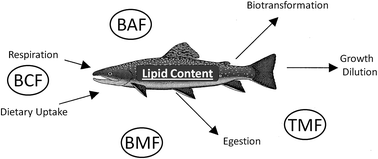当前位置:
X-MOL 学术
›
Environ. Sci.: Processes Impacts
›
论文详情
Our official English website, www.x-mol.net, welcomes your
feedback! (Note: you will need to create a separate account there.)
Bioconcentration, bioaccumulation, biomagnification and trophic magnification: a modelling perspective
Environmental Science: Processes & Impacts ( IF 4.3 ) Pub Date : 2017-12-08 00:00:00 , DOI: 10.1039/c7em00485k Donald Mackay 1, 2, 3, 4, 5 , Alena K. D. Celsie 1, 2, 3, 4, 5 , David E. Powell 6, 7, 8 , J. Mark Parnis 1, 2, 3, 4, 5
Environmental Science: Processes & Impacts ( IF 4.3 ) Pub Date : 2017-12-08 00:00:00 , DOI: 10.1039/c7em00485k Donald Mackay 1, 2, 3, 4, 5 , Alena K. D. Celsie 1, 2, 3, 4, 5 , David E. Powell 6, 7, 8 , J. Mark Parnis 1, 2, 3, 4, 5
Affiliation

|
We present a modelling perspective on quantifying metrics of bio-uptake of organic chemicals in fish. The models can be in concentration, partition ratio, rate constant (CKk) format or fugacity, Z and D value (fZD) format that are shown to be exactly equivalent, each having it merits. For most purposes a simple, parameter-parsimonious one compartment steady-state model containing some 13 parameters is adequate for obtaining an appreciation of the uptake equilibria and kinetics for scientific and regulatory purposes. Such a model is first applied to the bioaccumulation of a series of hypothetical, non-biotransforming chemicals with log KOW (octanol–water partition ratio) values of 4 to 8 in 10 g fish ranging in lipid contents to deduce wet-weight and lipid normalized concentrations, bioaccumulation and biomagnification factors. The sensitivity of biomagnification factors to relative lipid contents is discussed. Second, a hypothetical 5 species linear food chain is simulated to evaluate trophic magnification factors (TMFs) showing the critical roles of KOW and biotransformation rate. It is shown that lipid normalization of concentrations is most insightful for less hydrophobic chemicals (log KOW < 5) when bio-uptake is largely controlled by respiratory intake and equilibrium (equi-fugacity) is approached. For more hydrophobic chemicals when dietary uptake kinetics dominate, wet weight concentrations and BMFs are more insightful. Finally, a preferred strategy is proposed to advance the science of bioaccumulation using a combination of well-designed ecosystem monitoring, laboratory determinations and modelling to confirm that the perceived state of the science contained in the models is consistent with observations.
中文翻译:

生物浓缩,生物富集,生物放大和营养放大:建模角度
我们提出了一种建模观点,用于量化鱼类中有机化学物质的生物摄取指标。这些模型可以是浓度,分配比,速率常数(CKk)格式或逸度,Z和D值(fZD)格式,显示为完全等效,各有优点。在大多数情况下,一个简单的,包含约13个参数的,与参数有关的单节稳态模型足以为科学和法规目的而获得对吸收平衡和动力学的认识。首先将这种模型应用于log K OW的一系列假设的非生物转化化学物质的生物累积 (辛醇-水分配比)在10克鱼中的脂质含量范围为4到8,以推断出湿重和脂质标准化浓度,生物蓄积性和生物放大系数。讨论了生物放大因子对相对脂质含量的敏感性。第二,一个假想的5种线性食物链被模拟以评估营养放大因子(TMFS)表示的关键作用ķ OW和生物转化率。结果表明,脂质标准化的浓度对于疏水性较低的化学品最有见地(log K OW<5)当生物摄取主要由呼吸摄取控制且达到平衡(等效烟度)时。对于更多的疏水性化学物质(当饮食摄取动力学起主导作用时),湿重浓度和BMF更具洞察力。最后,提出了一种优选的策略,以结合精心设计的生态系统监控,实验室确定和建模来推进生物蓄积科学,以确认模型中包含的科学感知状态与观测结果一致。
更新日期:2017-12-08
中文翻译:

生物浓缩,生物富集,生物放大和营养放大:建模角度
我们提出了一种建模观点,用于量化鱼类中有机化学物质的生物摄取指标。这些模型可以是浓度,分配比,速率常数(CKk)格式或逸度,Z和D值(fZD)格式,显示为完全等效,各有优点。在大多数情况下,一个简单的,包含约13个参数的,与参数有关的单节稳态模型足以为科学和法规目的而获得对吸收平衡和动力学的认识。首先将这种模型应用于log K OW的一系列假设的非生物转化化学物质的生物累积 (辛醇-水分配比)在10克鱼中的脂质含量范围为4到8,以推断出湿重和脂质标准化浓度,生物蓄积性和生物放大系数。讨论了生物放大因子对相对脂质含量的敏感性。第二,一个假想的5种线性食物链被模拟以评估营养放大因子(TMFS)表示的关键作用ķ OW和生物转化率。结果表明,脂质标准化的浓度对于疏水性较低的化学品最有见地(log K OW<5)当生物摄取主要由呼吸摄取控制且达到平衡(等效烟度)时。对于更多的疏水性化学物质(当饮食摄取动力学起主导作用时),湿重浓度和BMF更具洞察力。最后,提出了一种优选的策略,以结合精心设计的生态系统监控,实验室确定和建模来推进生物蓄积科学,以确认模型中包含的科学感知状态与观测结果一致。











































 京公网安备 11010802027423号
京公网安备 11010802027423号